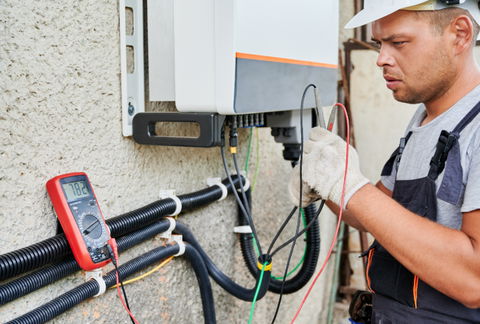When engineering electrical apparatus or systems, an enclosure plays a crucial part. The enclosure is needed to protect valuable electrical components from outside threats and people from equipment threats. This article provides a quick glance and tips on how to prevent condensation inside an electrical enclosure.

Condensation is formed of water droplets that gather on a cold surface when humid air is present. This is especially likely to happen outdoors when moisture and temperature changes are present. Electronics and electrical components don't like water and, therefore, moisture near these components means that there is the risk of a malfunction occurring, or even a total failure of the product.
Normally, in outdoor conditions, the surface of any electrical enclosure cools down during the nighttime. In the early morning, the ambient temperature rises more quickly than the temperature inside the enclosure. Surface moisture is able to evaporate from the cold surfaces when the temperature rises. However, inside electrical enclosure there is always the risk that moisture is not able to evaporate, with the possible result that it may cause long-term moisture-related conditions.
How does condensation affect electronic components?
- Condensation gradually decreases the performance of the components
- It can cause increased resistance in components, which itself creates heat build up
- It can lower the performance of the components or make that performance inconsistent
- There is the risk of short-circuiting, because moisture which contains impurities also conducts electricity
- In time, moisture will corrode components, allowing rust to develop. It may even corrode the metal enclosure that is supposed to protect the components
Finding a malfunctioning terminal or other electrical component that has been affected by moisture is somewhat difficult as any related problems are not always critical in the first place. As the malfunction triggers inconsistent product performance, the maintenance team needs to conduct a manual check of all of the electrical components. If there are a hundred electrical boxes to check, the time needed to go through all of these can be extensive, and will result in increasing operational costs.
How to prevent condensation inside an electrical enclosure
An ideal way to prevent water condensation inside any enclosure is to prevent moisture getting inside the enclosure in the first place. However, in real life, this kind of protection is not always possible and we need to have other ways in which we can prevent condensation from forming.
Here are three top tips:
- Position the enclosure away from any temperature fluctuations (such as direct sunlight or engines, for example)
- Avoid any very damp location (such as by the sea or near large areas of water pooling)
- Add ventilation or heating device to the enclosure
If you are not able to position an enclosure away from any temperature fluctuations and damp areas, then two of the most-often used ways to prevent condensation are ventilation and heating devices.
One benefit that non-metallic enclosures have over metallic enclosures is that the insulation properties are better and the heating capacity is lower. This means that when there is a rapid air temperature change, a plastic enclosure will adapt more quickly to the new environmental temperature and less water will condense on its surfaces.
The higher the IP rating is for the system, the harder it is for moisture to be drawn away from the enclosure. Therefore, low IP rated enclosures require less ventilation as the air is already circulating through gaskets and other leak points. The ventilation solution is more critical to high IP rated enclosures.
Ventilation device
Ventilation devices can be divided into active and passive types. Active ventilation has an electric fan, which circulates the air out of the enclosure. Passive ventilation means using cross-ventilation, where both sides of the enclosure have ventilation equipment, which draws the air through them.
For example, one of these could be fitted on the bottom right-hand side and the other on the top left-hand side of the enclosure. The cold air will come in from the bottom and warm air will go out from the top. Passive ventilation is more reliable and economical, but the air flow is not as efficient. Large cabinets normally have active ventilation, which uses a fan.
Heating device
Heating devices warms the temperature inside the enclosure and prevents moisture from condensing on the surfaces. Heating devices will, quite naturally, use electricity to heat up the enclosure or cabinet and keep the temperature above the dew point, so that moisture from the air does not condense on the surfaces. Heating device is reliable but more expensive solution.
CONCLUSION
When installing electrical enclosures in outdoor areas such as close to the seashore, in areas that are prone to heavy rain, in locations that can suffer extreme temperature changes or where the humidity levels are excessively high, some thought should be given to avoiding malfunctions and lower performance levels for products due to that moisture.
Using proper electrical junction boxes with the correct accessories means that such issues can be avoided, so that no time or energy is lost in conducting additional operational activities.
For more information, please contact www.fibox.com.
